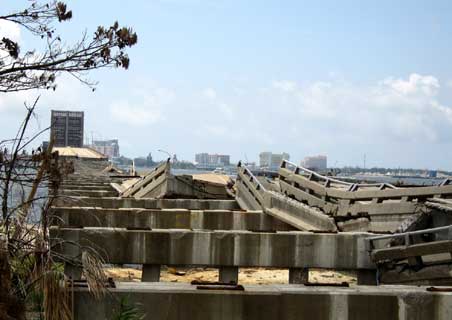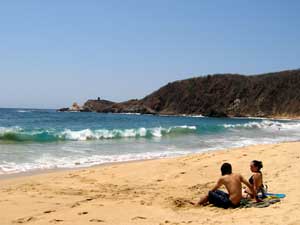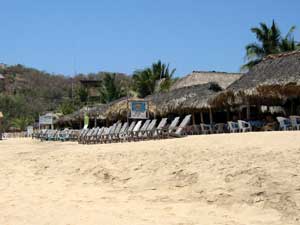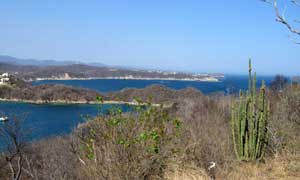April 25, 2006
Proud of Birgitta

|
Published: April 11, 2006
Birgitta Sundstrom:
See what immigrants have done here
they planted flowers, opened new businesses,
and year by year made things safer and better.
Birgitta Sundstrom
Since when has our state had a problem with illegal immigrants? As a letter carrier for five years in south Minneapolis I have seen what illegal immigrants can do. I watched neighborhood after neighborhood clean up because of illegal immigrants. Bloomington Avenue, 15th, 17th, Pleasant, Pillsbury all went from brown and sad-looking to green and blooming. I watched mothers and fathers working four jobs and paying taxes teach their kids the real value of a dollar. I have seen the "American Dream" really happen, time and time again. Which illegal immigrants is Gov. Tim Pawlenty actually after? What is he trying to stop here? Has he even walked around Powderhorn in his life? When I was a kid our family lived on 33rd and Portland. In 1979 my parents moved my brother and me to Bloomington after our house was broken into for like the third time. The neighborhood was bad. It was dangerous. Fourth Avenue was infested with crack and violent crime. My parents loved the city, but they had kids and needed to do what was best. Then in 1994 I moved back. I bought my first house in Powderhorn for $54,000. Over the years that I lived there I watched the neighborhood change. Every year it became a little bit safer. In seven years' time my duplex tripled in value. I thank all those dangerous immigrants who moved into my neighborhood. I thank them all. Not for the revenue or taxes, but for bringing back the beauty of south Minneapolis. For cleaning up a neighborhood that no one seemed to care about. For growing grass, for planting flowers, for opening new businesses, for coming to America and making it better, I thank them all. So the next time you're in an immigrant neighborhood, stop and really look around. See what immigrants have done for Minnesota. I say Minnesota should create its own immigration policy and welcome more people who care where their kids are raised and dream of a better life -- a better America.Birgitta Sundstrom, Bloomington, is a student at Metro State University.
©2006 Star Tribune. All rights reserved.
We can be proud of our children for all kinds of reasons. We are very proud of both of our children, especially now that they have become such wonderful adults. They are very much imbued with the values of Betty and me. When we see those values in action, we get even prouder.
Birgitta

We are always talking about writing letters to the editor, but rarely send something in. It was to our surprise and delight to discover that Birgitta sent an op-ed piece into the Minneapolis StarTribune. The Strib not only liked the piece but they also published it on the 11th of April and they paid her for it.
We both agree with her opinion. Like her we have seen the marvelous things that Mexican immigrants have done for the Twin Cities and the Midwest. Like her we value their contribution to our region and the United States. Like her we find the politicians that attack Latin American immigrants to be disgusting fear-mongers.
We always knew that Birgitta had the talent to be a great writer.
We hope that she continues on this path.
You can read her op-ed piece on the right side of this page, where I have reprinted it.
You can also find the piece of the
StarTribune web site.
If you have not read it already, I hope you will take the time to read it now.
April 23, 2006
The Long Drive
The long drive really started in Xalapa. I already wrote about the drive from Xalapa to Matamoros, which took two days. Tuesday, the 18th of April, we crossed the border into the USA and the city of Brownsville, Texas. We drove across the entire state of Texas passing by the fields and brush land of southern Texas. We passed by Corpus Christi and drove through the heart of Houston. We were in east Texas, then in Louisiana, stopping in Lafayette. The driving was starting to get to me, having driven about ten hours a day for the previous three days. On Wednesday we drove the last 200 miles to my father's home in Ocean Springs, Mississippi. We drove though the Atchafalaya basin, and Baton Rouge, and north of Lake Pontchartrain, avoiding New Orleans. We arrived before noon and the four of us went out for a very late breakfast.
After lunch, Dad drove us around us around Ocean Springs and the gulf coast to the west, where so much had been destroyed by hurricane Katrina last September. Having been here many times before the storm, and - despite all the clean up - I was shocked by the level of destruction. Business after business was just gone, or in total ruins. Especially significant was the destruction of the gigantic floating casinos of Biloxi. These multistory edifices were built on floating barges that were hundred of feet long and wide. One floated more than a kilometer from where it was moored to land on top of a very large hotel, which it flattened. Where there had been block after block of homes along the coast, there is nothing. We did not drive all the way to Pass Christian, but over 80% of the homes were wiped out by the storm. Thousands of homes were flood on the back bays when the storm surge raised the ocean water level by as much as 20 feet. The result was that thousands of homes we despoiled. Clean up of those homes required gutting the insides to bare studs, then letting them dry out. This is where most of the reconstruction is at now with the removal of most debris and the gutting of most buildings.
What surprised me was the willingness to rebuild, even within one-hundred meters of the shoreline. I saw a wood-frame new building going up less than 100 feet from the shore. I could only shake my head and ask why the city would permit the redevelopment so close to the shore and with no new zoning and building codes? It is certain that in the next ten to thirty years the people of the United States will be called on again to spend billions - so that a few can enjoy living on the water.
Press HERE to see a slideshow
from Saint Louis.
Here We Are at the Top of the Arch 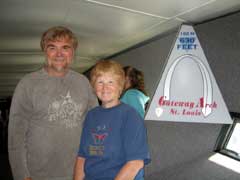 |
The Mighty Mississippi from the Top  |
Downtown St. Louis from the Top 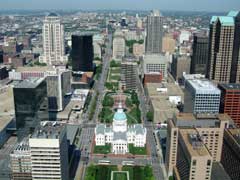 |
Not as surprising, has been the tremendous outpouring of support to the people of the gulf coast. My dad has played a significant role in organizing the clean up and reconstruction through his church. His stories of the thousands of people who came to volunteer and who will continue to come, brought tears to my eyes. And beyond the real on the ground support, the people of America gave and gave and gave, sending thousands of truckloads of food and clothing and supplies to rebuild. One might call it miraculous, but then again - we can pull together when we need to.
St. Louis Arch

Link to Arch Movie (50MB)
On Thursday we just hung out and talked. Dad had me help him finish a couple of repairs to his house and we hung two light fixtures. My dad's house was high enough and far enough from both the shoreline and the back bay, so that his home only suffered minor damage. It was a great day with them.
Friday, we headed north driving more than 600 miles or about 1000 kilometers. We passed through the pine forests of mid-Mississippi. Memphis went by in a flash, then we were in Arkansas for an hour or so. Missouri is beautiful this time of the year. So verdant, so green, that it felt like heaven to me. We stopped just a half-an-hour shy of Saint Louis, Missouri.
We started yesterday, Saturday, with a visit to Saint Louis. Betty had never been to Saint Louis before. We started with a close-up look at the Saint Louis Gateway Arch. We took a number of photos and a short movie of the arch, but there are some great pictures at the official arch web site. After visiting the Gateway Arch we drove through the downtown Saint Louis, which a really beautiful city. All the buildings along its central mall were stunning. The mall must be more than a mile long.
Before noon we were headed toward Hannibal, Missouri. We did not stop at Mark Twain's house; we just kept on heading north. By mid-afternoon we were passing by the freshly plowed, rich, black and loamy fields of rural Iowa. We passed through Iowa City, then Cedar Rapids, Waterloo, and Mason City. Turning north on I-35 we were in Minnesota one-half an hour later. Finally we arrived at the house in Bloomington that we left four months ago, and more than 12,000 miles or 19,500 kilometers.
That wraps up this trip. We will be going on several short trips this summer and a very long one in the fall. I will try to write some comments on Mexico in the next few days.
April 17, 2006
The Beautiful State of Veracruz
Press HERE to see a slideshow from the Beautiful Veracruz State
Catemaco 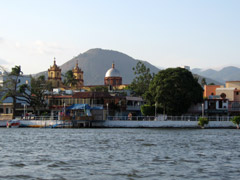 |
One of the Herons' Trees 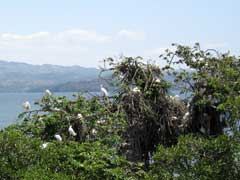 |
Fisherman on Lake Catemaco 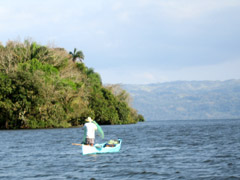 |
Cruising the Lake |
A Baby Monkey  |
Pastoral Sontecomapan  |
In truth it was a long drive from Huatulco to the beautiful state of Veracruz. For me Veracruz is the best of all the Mexican states as will be come evident as you read this entry. I have driven further, but not when I was not feeling so great. The first two hours were the worse as the road wound back and forth. Still on the Pacific coast in Oaxaca, as we approached Salina Cruz, the highway finally straightened out. About six hours after departing we finally arrived at Lake Catemaco. It is a very large volcanic lake with a circumference of sixty-five miles. It is truly a wonderful place. We found a good and inexpensive ($33/night) hotel right on the lake and in the town of Catemaco. The Hotel del Brujo was great, save one flaw: like so many other places in Mexico, the plumbing was not vented. This means that you must leave the bathroom door shut or enjoy the wafting sewer gases. The hotel was probably named after the annual of convention of witchdoctors that visit the area every March.
I cannot say that we did all that much. I crashed right away after checking in. I was bushed from the driving and being sick. The next day we again did not do much. We enjoyed the tree full of Herons that was right in front of our hotel. As I looked around, I saw many more. I could hardly believe that so many big birds could be living in a single tree. We wondered around the town visiting the usual places: the zocolo and the main church. Later in the day we took a lake tour on a boat. It was great. One anomaly on the lake was the monkeys on the little islands. They were imported from Thailand years ago for a University of Veracruz psychology experiment. They are still studying them, but they have become quite the tourist attraction.
Los Tuxtlas Beach 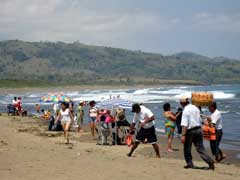 |
Public Art on the Pier 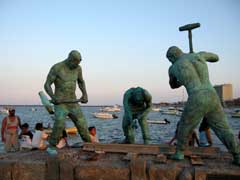 |
In a Working Port  |
Veracruz as Sunset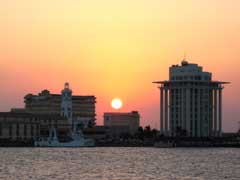 |
Children Frolicking in Fountain  |
Public Art  |
and More Public Art 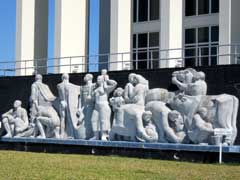 |
Old Naval Buildings 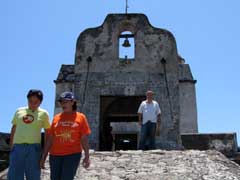 |
We took an unconventional road to Veracruz city. It winds down to beautiful Laguna del Sontecomapan that is really a bay that cuts deep into the land. The pastoral scenes were wonderful. Soon we were on the coast. There are some beautiful beaches in Los Tuxtlas. And the area is totally undeveloped. True there is a town here or there where people come to camp or enjoy a day on the beach, but by-and-large the cows control the coastline.
The city of Veracruz is a nice place to visit for a few days. The city is growing rapidly and there is quite a bit of development on its south side along the coast: new hotels, beach resorts, condominiums, restaurants, shopping centers. There is a historic district that is nice, but nothing special. We stayed at an ordinary hotel on the beach, just a kilometer from the town's historical center. We wandered around enjoying the crowds of holiday (Easter) vacationers, and the ambience of this very old working port. It is a pleasant and green city, and it is very humid. I am sure that it looks a lot like Miami did years ago.
Park in Xalapa 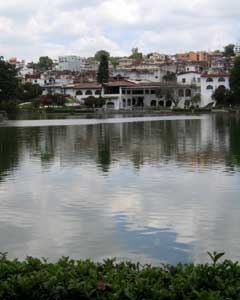 |
Child in the Park 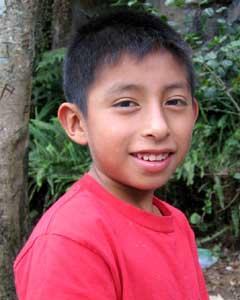 |
A Busy Alley 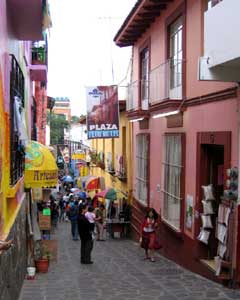 |
Hotel Cantón Juárez  |
Strong Families 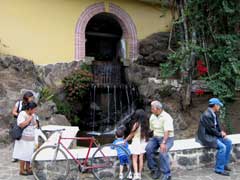 |
Fun People  |
Ancient Civilization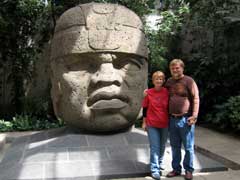 |
Tampico's Zocolo 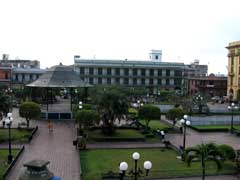 |
Last Thursday we headed to Xalapa (or Jalapa). It is only sixty miles away, but what a different place. There is low humidity. It is at 4000 feet and thus quite cool. It is the capital of the province and has a university. It too has seen quite a bit of development lately. I love the place and I was surprised when Betty agreed with my assessment. We found an extremely nice hotel just block from the Zocolo and cathedral. It was the cheapest of the places we have stay at, just $23 per night. It was the cleanest. There was a TV with cable. The town and the hotel were so nice that Betty decided to stay an extra day. Not that we did all that much, I guess - if you really enjoy a place - you don't have to do all that much. We hung out in the parks, enjoyed good meals, went to a movie, and visited a great anthropological museum. The only thing that I regret is that we missed seeing my friend, Hélè ne Peclers. She is from Xalapa, but she has been studying in Spain. She was due to return today, but we just could not stay longer. We hope to see her on our next visit. Yes, Xalapa is a city that we will definitely be returning to.
Yesterday was a very hard day of driving. We drove to Tampico and it took all day. We saw some beautiful scenery: from cattle farms to banana plantations on a road that wound on and on and on. When we finally got down to the coast we discovered a number of great beach towns near Barra de Nautla. We were determined to make Tampico. Not far from this area is Papantla. We stopped in Papantla to buy a pound of vanilla beans. It is the vanilla center of Mexico. We had planned to visit El Tajin, which was five miles from Papantla. It is one of the largest archeology sites in Mexico. We were not the only ones with this thought. Based on the cars in their lots more than 5000 people had decided to visit El Tajin on this beautiful Easter. So rather than fight the crowds we decided to skip it this time and save it for the next time we go to Mexico.
We got to Tampico about seven in the evening. First, we searched for a place to stay at the expensive beach hotel on the Miramar beach. There had been tens of thousands enjoying the sun and surf that days, most of whom were on their way home just as we were arriving. We spent too much time looking and eventually decided to skip the beach where the only decent hotels cost about $140 per night. We ended up in an old hotel on the Zocolo downtown. From what we saw, we can say that we do not care much for Tamipco.
Today we drove to Matamoros, which on the border just across from Brownsville, Texas. The roads were great on this stretch and we made very good time.
After nearly three months in Mexico, we will drive across the border tomorrow, heading north and eventually to my dad's home in Ocean Springs, Mississippi.
Well, that's it until next time.
April 08, 2006
Oaxaca and More
During our final week in Cuernavaca we got just a bit busier. We drove into Mexico City on Sunday. Traffic was light and it was easy to get there and get around. We spent most of our time at the anthropology museum. I had been there before, but Betty had not. It is one of the best of these types of museums and well worth visiting. The quality and quantity of the artifacts makes it a must. It is so large that we quit after about four hours. We probably saw a little more than half of the museum. After our visit, we drove to the historical center of the city. It is an amazing and beautiful part of the city. Visitors to Mexico should try to spend some time in Mexico City, because of its beauty and age. While we were there, the youth of the city were beginning to gather for a huge rock concert planned for on the Zócalo, or central square of the city. We left just before dark, taking the free road to back to Curernavaca in a little over one hour..
On Tuesday we drove to Taxco, the silver capital of Mexico. It is a pretty little town that hundreds of tourists visit everyday. We walked from shop to shop to shop. When we got tired we stopped to lunch at one of the many rooftop restaurants. I picked up a straw hat and Betty bought a present. It is a nice day trip when you are in Cuernavaca.
Press HERE to see a slideshow from Oaxaca and more.
Oaxacan Ladies  |
Grasshoppers Anyone? 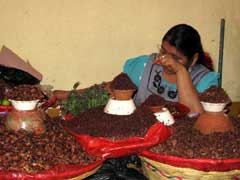 |
Market Shrimp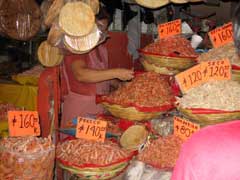 |
Chickens to Eat 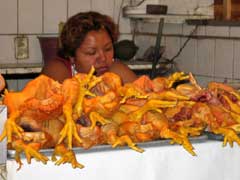 |
A week-ago on Friday at midday, we picked up Megan Cowell and headed for Oaxaca. We had invited her to join us for a few days. It is about a seven hour drive to the city of Oaxaca. It was a typical Mexican two lane road that brought you through the center of every little village. The country side was interesting with huge cacti and mountain switchbacks. We arrived just as the sun was setting. We looked and looked for an acceptable hotel, finally finding one about nine. Tired and thirsty, we walked to the Zócolo for some refreshments.
On Saturday, we concentrated on shopping in the city markets. There was an artisan market, mostly with clothing. We all bought something: I got a Mexican dress shirt; and Betty got a pair of shorts; and Megan bought some gifts. Then there was the general market with flowers and food and more clothing and stuff for the house. The ladies tasted the local popular seasoning of ground up grasshoppers. Later we all bought some of the famous Oaxacan chocolate. I got a kilo of coffee, which we prepared for our breakfasts. There were a large number of stores that we visited. There was supposed to be a large cultural event that we could not seem to connect with. We visited one of the many beautiful cathedrals in the city. In the evening Megan and I went out to a club. She was salsa dancing and I enjoyed the crowd.
On Sunday we did the free things that can be done on Sundays. First we visited Monte Alban. It is one of the most spectacular archeological sites in Mexico. Most of its structures are about 1000 years old. We spent three or four hours roaming from one building to the next. After that it was to the free museums. The modern art museum had the works of single artist. It did not do much for me. It consisted of hundreds of clay nearly life-size statues of people that represent the migration of people. Then it was Oaxaca's history museum. It had some fantastically good quality pieces, especially the ancient Zapotec Indian artifacts. There was also a great garden that we could see from the large open windows of the museum. We were exhausted, and the day was coming to an end. We walked down to the Zocolo for beers and a bite to eat.
Photographs from Monte Alban
 |
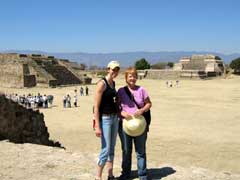 |
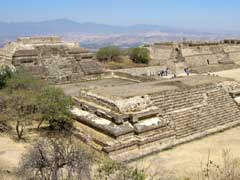 |
 |
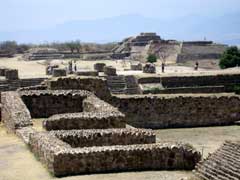 |
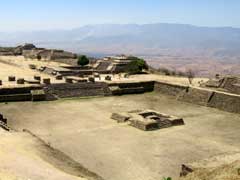 |
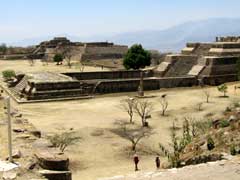 |
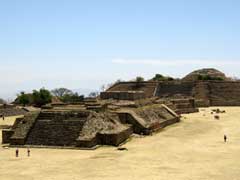 |
On Monday we did a driving tour of the city and a trip to Tlacolula, a small town 15 miles east of Oaxaca. There was a small market with a few things for sale. Betty bought a bag of fresh cumin. The main point was to see a bit of the city and then a bit of the surrounding countryside. Unfortunately for Megan I choose the wrong direction. We should have headed south. When we got back we took a break, and about 8:00 we went out for dinner. After dinner we said our good-byes to Megan. She caught the midnight bus to Mexico City.
Tuesday: We headed south on highway 175 toward Puerto Angel. It is a much better road than the one to Puerto Escondido. Before we got clear of the area, Betty and I took a little side trip to San Antonio Arrozola. In this little village, the bulk of the Oaxacan wooden carvings are produced. They are wonderful and fanciful. I am not sure how much cheaper they are in this village, but for sure the variety is grand. We bought a few items from a workshop where we saw pieces being carved and painted.
From here we got back on 175 and stopped at the village of San Bartolo Coyotepec, where much of the Oaxacan black pottery is made. We went to a factory store for Donna Rosa and bought eight to ten pieces for about $27 USD.
Five or six hours of hard driving later we drove into Puerto Angel. It is a much smaller and quieter town than Puerto Escondido, but this is where we planned to spend the next three nights. We had a good sea food dinner that night.
Carvers at Work 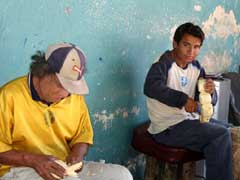 |
Painting the Piece 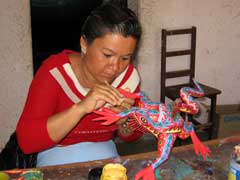 |
Beautiful Results  |
Carvings Galore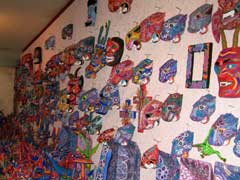 |
Wednesday was the first of several days on the beach. We stayed at a Hotel La Cabaña on the west side of the bay. It was nice and cheap for Mexico at $30 USD a night. We only had to walk across the road to the beach, all of 40 meters. We spent the entire day swimming, reading, eating and drinking on the beach.
There are several small villages just east of Puerto Angel. The furthest one is Mazunte, a six mile drive. We drove there on Thursday, passing through the other two towns, Zipolite and San Agustinillo. We planned to visit them as we made our way back to Puerto Angel. But the best laid plans never see the light of day. Again we spent the entire day watching the waves roll in. We had brought a liter of rum and were soon downing it with a pitcher of fruit juice I ordered. As the day wore on some American students sat at the table next to us. They were studying Spanish in Oaxaca, but were also seeing much of the country. We like them all. There was Megan, Kylie, Zach and Daniel Thurston Grant - what a moniker. Near the end of the day a couple from St. Paul sat down at another table next to us. They were Jan and Jim. From what we could tell they are regular visitors to Mexico, coming down at least a couple of times each year.
Friday we drove thirty miles east to Bahías de Huatulco. The furthest west and most inaccessible is Bahia San Agustin. We heard that it was a real Mexican place that was quiet and nice to visit. So we drove the 8 miles down the dirt side road. It is beautiful, but there are no rooms in this village. We had a drink and head back to the main road and into La Crucecita, the main town that is the gate way to the Bahías. We quickly got a room in a posada. Compared to the rest of the rooms in the town, it was cheap at $50 per night. Prices have exploded in the area in the past two years. It is very clean and well set up for handling lots of tourist. Still in 2005 there were only 1800 flights into their international airport. In years to come, I expect that the prices and number of tourists will soar. We headed to the closest beach and had lunch. I never had tough fish before, but I did there. Still it tasted great. After eating we decided to drive to all the little bays along the coast. We got to most of them, and saw some huge and beautiful resorts. Places that we would never stay at - but still it was fun to look.
Saturday, the 8th of April, Betty's birthday
It is clear that Betty is getting tired of traveling. The Plan was to spend the next three weeks winding our way back the 3000 kilometers back to Minnesota. This plan may need to change.
In any case in is our last day in Bahías de Huatulco. Again we spent the day on the beach. It was absolutely lovely. The bays are small, so the people seem to fill the entire beach. We drank and swam and enjoyed ourselves. In the evening we had pizza and went to bed early. Tomorrow we would be on our way to the province of Veracruz.
